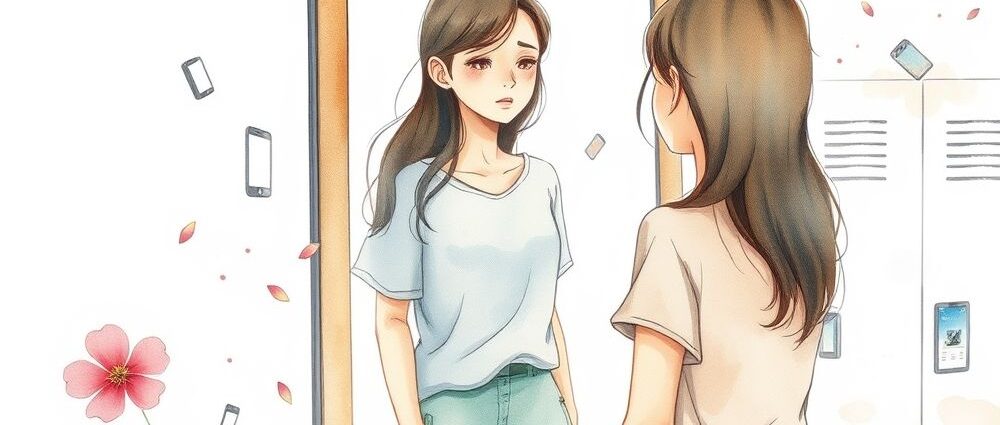Look, I’m just going to say it – your phone might be aging you faster than that expensive anti-wrinkle cream is working to fix things. Actually, scratch that… it’s definitely doing something to your skin, and not in the good way.
You know that slightly panicked feeling when you check your screen time report and realize you’ve been staring at devices for eight hours? Well, turns out your skin has been getting that same eight-hour exposure to something called blue light skin damage. And honestly, it’s kind of wild that we’re just now talking about this.
I mean, we’ve been obsessing over UV rays and slathering on sunscreen for years, but somehow missed the fact that our beloved screens are basically tiny light therapy devices pointed straight at our faces all day long. The thing is, blue light – that high-energy visible light beaming from your laptop, phone, and TV – can actually penetrate deeper into your skin than UV rays. Deeper. Than. UV. Rays.
What Exactly Is Blue Light Doing to Your Face?
So here’s where it gets interesting – and by interesting, I mean slightly terrifying. Blue light doesn’t just mess with your sleep cycle (though it absolutely does that too). Research shows it’s literally changing your skin cells at a molecular level.
When blue light hits your skin, it triggers this whole cascade of not-so-great things. First, it cranks up the production of reactive oxygen species – basically free radicals that go around damaging your skin’s DNA, collagen, and pretty much everything else they can get their destructive little hands on.
And collagen? That’s the stuff that keeps your skin bouncy and smooth. When blue light breaks it down, you’re looking at accelerated aging – wrinkles, fine lines, sagging, the whole nine yards. It’s like your skin is on fast-forward, and not the fun kind.
Here’s what really got me though – studies have found that just four regular workdays in front of a screen equals about 20 minutes of afternoon sun exposure. Twenty minutes! That’s barely enough time to get a decent tan line, but apparently enough to start the aging process.
The Hyperpigmentation Problem Nobody Warned You About
If you have medium to dark skin, this next part is especially important. Turns out, blue light is particularly good at triggering hyperpigmentation – those dark spots and patches that seem to appear out of nowhere.
A 2010 study found that when skin was exposed to blue light, it caused more pronounced darkening than even UVB rays. And that darkening? It stuck around for months. So if you’ve been wondering why your complexion looks uneven despite your diligent skincare routine, your screen time might be the culprit.
The worst part is that this hyperpigmentation from blue light exposure tends to be darker and more persistent than sun damage. It’s sneaky because you don’t get the immediate feedback like redness or burning that tells you “hey, maybe take a break.”
Tech Neck – The Wrinkles You Didn’t See Coming
Can we talk about tech neck for a second? Because apparently, it’s not just about neck pain anymore. All that hunching over your phone and laptop is creating horizontal lines across your neck – permanent ones.
The skin on your neck is already thinner and more delicate than your face, so it shows aging signs faster. Add in the constant folding and creasing from looking down at devices, and you’re basically creating a roadmap of wrinkles. Some people are seeing these tech neck lines in their twenties now. Their twenties!
And don’t even get me started on the squinting. All that peering at screens, especially in bright light or when you’re trying to read tiny text, is creating crow’s feet and forehead lines faster than you can say “blue light filter.”
Your Sleep, Your Skin, and the Vicious Cycle
Here’s where things get really interconnected. Blue light exposure, especially at night, messes with your melatonin production. Poor sleep doesn’t just leave you feeling groggy – it literally prevents your skin from doing its overnight repair work.
Your skin cells regenerate and repair damage while you sleep. When blue light disrupts that process, you’re not just tired the next day; your skin is accumulating damage it can’t properly fix. It’s like having a maintenance crew that only works the night shift, but you keep the lights on and tell them to go home.
The result? Dull skin, dark circles, increased sensitivity, and basically everything that makes you look older and more worn down. Your skin starts looking like how you feel after pulling an all-nighter – which, if you’re scrolling until midnight, you basically are.
The Science Behind Screen Time Skin Damage
Let me get a bit nerdy for a minute because the research on this is actually fascinating. Blue light operates in the 400-500 nanometer range, which puts it right next to UV radiation on the electromagnetic spectrum. It’s got enough energy to penetrate past your skin’s surface and reach the deeper layers where your collagen and elastin live.
When blue light hits those deeper layers, it doesn’t just cause surface damage. It triggers inflammatory processes that break down your skin’s structural proteins. Studies have shown that even 60 minutes of exposure can cause changes in skin cells, including cell shrinkage and death. Sixty minutes! That’s like, one Netflix episode.
The really concerning part is that we don’t have decades of research on this like we do with UV damage. We’re essentially the first generation to be this chronically exposed to artificial blue light, so we’re figuring out the long-term effects as we go.
Why Your Regular Sunscreen Isn’t Enough
Plot twist – your regular SPF probably isn’t protecting you from blue light skin damage. Most traditional sunscreens are designed to block UV rays, not visible light. So you could be diligently applying your SPF 50 every morning and still getting hit with blue light all day long.
What you need is sunscreen with iron oxide. Iron oxide is like the superhero of blue light protection – it can actually block visible light, including blue light. That’s why tinted sunscreens often provide better protection against blue light skin damage than clear formulas.
But here’s the thing – even the best sunscreen isn’t a complete solution if you’re spending 8+ hours a day inches away from glowing screens. It’s like trying to block a fire hose with an umbrella. Helpful, but not exactly comprehensive protection.
The Hidden Damage You Can’t See Yet
What’s particularly sneaky about blue light skin damage is that it’s cumulative. Unlike a sunburn, which gives you immediate feedback that you’ve overdone it, blue light skin damage builds up slowly over time. You might not notice anything different day to day, but over months and years, the effects compound.
Think about it – we’ve only had smartphones for about 15 years, and high-definition screens with intense blue light for even less time. The people who’ve been early adopters of all this technology are just now hitting their 30s and 40s, which is when aging signs typically become more noticeable anyway.
But some dermatologists are reporting that they’re seeing aging signs in younger patients that they historically wouldn’t expect to see until later. Coincidence? Maybe. But probably not.
Real Talk About Digital Detoxing Your Skin
Look, I’m not going to sit here and tell you to throw your phone in a drawer and go live in the woods. That’s not realistic, and honestly, I’d last about 3 hours before I’d be back to scrolling. But there are things you can do that actually make a difference.
First, night mode is your friend. Most devices now have settings that reduce blue light emission, especially in the evening. Apple calls it Night Shift, Android has Blue Light Filter – whatever your device calls it, use it. The warmer, yellower light is much gentler on your skin.
Second, distance matters. The closer you are to the screen, the more intense the exposure. So maybe don’t watch Netflix with your tablet literally touching your nose. I know, I know – subtitles are tiny and your eyesight isn’t what it used to be. But even holding your device an arm’s length away significantly reduces the intensity of blue light skin damage hitting you.
Skincare That Actually Fights Screen Time Damage
Here’s where the beauty industry has actually stepped up. There are now products specifically formulated to combat blue light skin damage, and some of them are legitimately helpful.
Antioxidant serums are your first line of defense. Vitamin C, vitamin E, niacinamide – these ingredients help neutralize those free radicals that blue light loves to create. It’s like having a cleanup crew for your skin cells.
But honestly? The most important thing is still sunscreen with iron oxide. Even if you’re staying indoors all day, that blue light protection is crucial. Look for tinted formulas or sunscreens that specifically mention visible light protection.
Retinol is also your friend here because it helps speed up cell turnover and can repair some of the collagen damage. Just be careful not to make your skin more sensitive by overdoing it.
The Postural Aging Nobody Talks About
Can we address the elephant in the room? The way we use our devices is creating physical changes in how we look, beyond just skin damage. “Tech neck” isn’t just about wrinkles – it’s about how constant forward head posture is changing the shape of our faces and necks.
When you’re constantly looking down, gravity pulls everything south. Your jawline, your cheeks, even your eyebrows. Combine that with the weakening of neck muscles from poor posture, and you’re looking at changes that go way beyond what any skincare product can fix.
The good news is that this is totally fixable with some awareness and effort. Elevate your screens to eye level when possible, take breaks to stretch and reset your posture, and maybe consider some neck exercises. Your future self will thank you.

What the Research Actually Says (And Doesn’t Say)
I want to be real with you about something – while there’s definitely evidence that blue light can damage skin, most of the studies have been done in labs on isolated skin cells, not on actual humans going about their daily lives. The research on blue light skin damage is still evolving.
What we do know is that blue light creates oxidative stress, breaks down collagen, and can trigger hyperpigmentation. We also know that it disrupts sleep, which indirectly affects skin health. But exactly how much screen time becomes problematic? How much protection do we actually need? Those answers are still being figured out.
That said, the precautionary principle applies here. We know enough to know that protection is probably a good idea, even if we don’t have every detail nailed down yet.
Breaking the Cycle Without Breaking Your Life
Let’s be practical about this. You’re not going to eliminate screens from your life, and I’m not going to pretend that’s a reasonable solution. But you can be smarter about how you use them.
The 20-20-20 rule is actually brilliant for more than just eye strain – every 20 minutes, look at something 20 feet away for 20 seconds. This gives your skin a break from direct blue light exposure and helps reset your posture.
Setting boundaries around screen time, especially in the evening, can help your sleep and give your skin time to repair. And investing in some basic protection – good sunscreen, antioxidant skincare, maybe some blue light filtering glasses – doesn’t have to be complicated or expensive.
Quick Takeaways
- Blue light from screens penetrates deeper into skin than UV rays and can cause premature aging
- Screen time equivalent to four workdays equals about 20 minutes of sun exposure in terms of skin damage
- People with darker skin are more susceptible to blue light-induced hyperpigmentation that can last for months
- Tech neck from poor device posture is creating permanent wrinkles and aging signs, especially on the neck
- Regular sunscreen doesn’t protect against blue light skin damage – you need formulas with iron oxide for visible light protection
- Poor sleep from nighttime blue light exposure prevents skin from repairing daily damage
- The 20-20-20 rule and night mode settings are simple ways to reduce exposure without major lifestyle changes
- Read Research on blue light skin damage
The Bottom Line (Because Someone Has to Say It)
Look, your screen time probably is affecting your skin. Not in a dramatic, immediate way like a sunburn, but in that slow, cumulative way that adds up over years. The good news is that small changes can make a real difference.
You don’t have to choose between staying connected and having healthy skin. But maybe it’s time to start thinking about blue light protection the same way we think about sun protection – as a basic part of taking care of ourselves in the modern world.
And honestly? Once you start paying attention to how much you’re actually on screens, you might be surprised. I know I was. That weekly screen time report is both a reality check and a wake-up call.
Your skin has been dealing with a lot more than you probably realized. Maybe it’s time to give it some help.
FAQs
Does blue light from phones really age your skin? Research suggests yes – blue light can penetrate deeper than UV rays and trigger oxidative stress that breaks down collagen. While your phone isn’t as intense as the sun, the cumulative exposure from hours of daily use can contribute to premature aging over time.
How long does it take for blue light skin damage to really show? Studies show that changes in skin cells can happen in as little as 60 minutes of exposure. However, visible signs like wrinkles or hyperpigmentation develop gradually over months or years of regular exposure.
Can I reverse blue light skin damage? Yes, to some extent. Antioxidant skincare, retinol products, and treatments like chemical peels or microneedling can help repair some damage. The key is combining treatment with protection to prevent further damage.
Is blue light worse for certain skin types? Medium to dark skin tones are more susceptible to blue light-induced hyperpigmentation, which tends to be darker and more persistent than UV-induced pigmentation. However, all skin types can experience collagen damage and premature aging from blue light exposure.
Do blue light glasses protect your face skin too? Blue light glasses primarily protect your eyes, but they do provide some protection for the skin around your eye area. For broader facial protection, you’d need sunscreen with iron oxide and antioxidant skincare products.
Should I wear sunscreen indoors if I’m on screens all day? Yes, especially if you’re concerned about blue light skin damage. Look for broad-spectrum sunscreens that contain iron oxide, which can block visible light including blue light. Tinted formulas often provide better blue light skin damage protection than clear ones.
What’s the difference between blue light from screens vs the sun? The sun emits much more intense blue light than screens, but screens expose you at very close range for extended periods. Some estimates suggest four workdays of screen time equals about 20 minutes of afternoon sun exposure in terms of skin impact.



